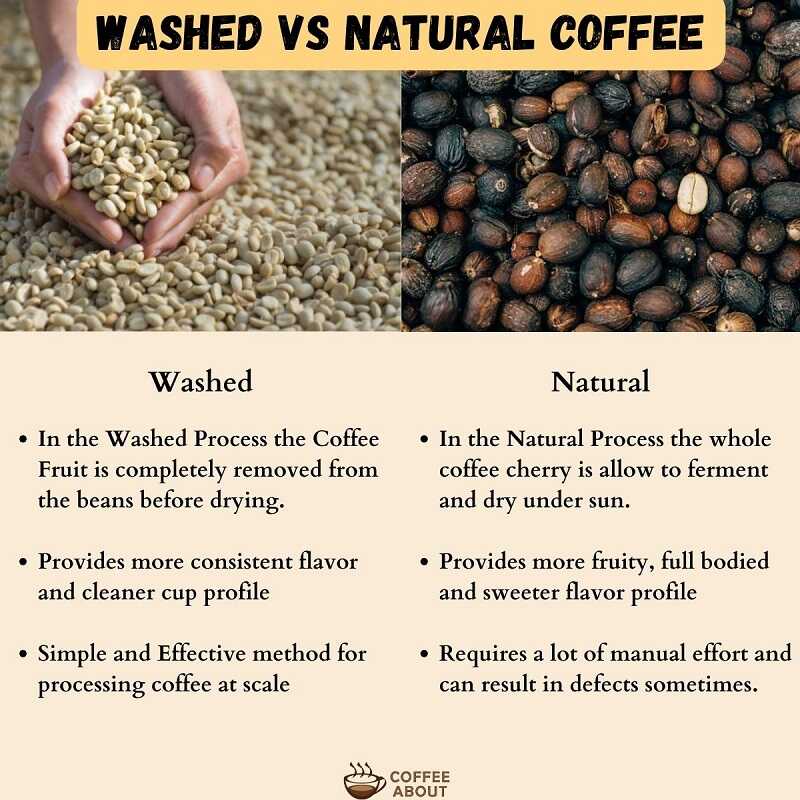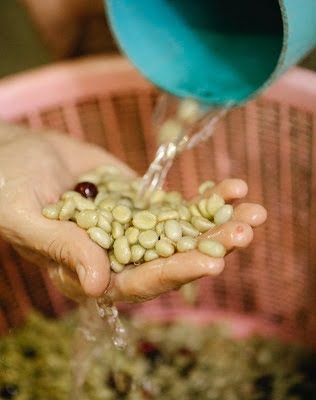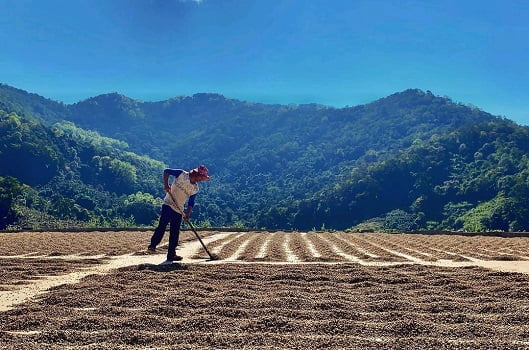The journey from freshly picked coffee cherry to a bag of roasted beans is complex. While most specialty coffee is either “washed” or “natural,” the differences between these two methods are far from black and white.
Key Takeaways
- The main difference is washed coffee process involves removing the fruit flesh before drying the bean while in the Natural process, the bean dries inside the cherry, absorbing sugars from the fruit.
- Washed coffee has a clean and consistent taste with pronounced acidity and only subtle fruity notes. Natural coffee has a fruity, syrupy taste with intense berry, sweet and fermented flavors.
- The amount of caffeine in both Washed and Natural process is the same. The type of processing doesn’t effect the caffeine content.
So which is best? It depends on who you ask. With so many factors at play, from variety to terroir to a farmer’s personal touch, there’s no definitive winner in the Washed vs Natural Coffee battle. But understanding how processing shapes flavor is key to choosing your perfect brew.

A Note on the Coffee Processing
Coffee Processing is the method of converting coffee cherries into finished coffee beans that we use to brew our favorite drink.
These coffee cherries are grown on trees and are picked when they’re ripe and ready to be harvested.
The fruity flesh must be removed from the beans first. There are two ways to do it: washed and natural process. Both include removing the outer cherry pulp after the cherries are harvested.
Coffee Processing is a science and art used by producers to alter and achieve a desired flavor profile from coffee beans.
Once processed, the green beans are sent to roasters to be roasted to various light, medium, and dark levels. Careful processing is key to crafting delicious coffee from the seed of the cherry!
What is the Washed Coffee Process?
In the Washed Coffee process, the beans are dried without the cherries. The organic matter is stripped soon after the cherries are plucked from the tree. Then the beans are fermented in water tanks to remove the remaining organic matter and after that, the clean beans are dried under the sun.

Here’s what the washed Coffee process looks like:
- Cherries are picked from the trees and brought to a washing station.
- At the station, the cherries are placed in water tanks. Good quality cherries sink to the bottom while lower quality, damaged, or under-ripe cherries float to the top and are removed.
- Next, the cherries go through a de-pulper machine to separate the beans from the outer skin of the cherry. At this point, there is still a sticky, sugary layer called mucilage surrounding the beans.
- Beans are placed in water tanks where the beans are fermented naturally or using yeasts and bacteria that eat away the mucilage layer. This process typically lasts for 18-24 hours.
- Lastly, the beans are washed with water properly to remove any sticky layer and then dried under the sun.
Recently, the washed coffee process has become the most popular way to prepare coffee beans around the World. Thanks to advances in science and technology in coffee production methods.
The wet process results in more predictable and consistent flavors, since the lower-quality cherries are removed during the process.
What is Natural/Dry Coffee Process?
In the Natural Coffee Process, the coffee cherries are dried under the sun before removing the outer layer. The natural or dry method is the oldest and more traditional way of processing coffee beans. It’s sometimes also called the sun-dried or cherry-dried method.
Natural processing is common in countries where there is less rainfall and lots of sunshine like Ethiopia and some areas of Brazil.

Here’s what the Natural/Dry Coffee process looks like:
- First, Unripe Green Cherries are removed from the Harvest manually.
- The ripe red cherries are placed out on patios to dry under the sun. The fruit stays intact on the beans during the drying phase.
- Workers manually mix and turn the cherries frequently, which helps them dry evenly. This drying stage lasts around 1-4 weeks depending on the weather and desired moisture content.
- Once the cherries are dried they are sent to a mill. Here’s where the fruit gets hulled off the beans.
- The beans then go through mechanical sorting to remove any defects, shells, or plant matter. Finally, the cleaned beans are bagged for export.
The natural method brings out more fruity flavors in the coffee, but there’s also a higher chance of defects. It requires more labor and expertise than washed processing.
The processor must take great care to prevent rotting or over-fermentation during the extended drying time.
The Difference in Taste of Washed vs Natural Coffee
Washed coffee is known for having a smooth, clean taste with vibrant flavors. You’ll pick more classic coffee notes, with high acidity and less body. Fruity flavors can still come through, but typically not as much as dry fermented coffee.
“With a washed coffee, you are tasting the coffee itself – the origin, the coffee variety, the terroir – and not the impact of the processing method.” – Perfect Daily Grind
Natural or Dry processed coffee delivers a fruitier and heavier-bodied coffee with more sweetness and less acidity. The aromas are often more intense and enticing. Natural coffee tends to highlight the fruity, fermented flavors since the bean stays in contact with the cherry longer.
“The natural process offers a fuller-bodied brew, with notes of “citrus, lime acidity,” or a strong “sweet, strawberry jam.” – Eaters
What’s Better, Washed or Natural Coffee?
If you are buying a nice Single Origin Coffee, Natural or Dry Processed Coffee will be a better choice as it will truly highlight the flavors of Origin and Terrior.
If you are buying Coffee blends, Washed Coffee will be a better choice as you will get nice consistent flavors.
The Pros of Washed Coffee
- There is a lower chance of defects like bad cherries, over-fermentation, or mold growth in the wet process.
- Washed Coffee delivers more consistent flavors with a clean and crispy taste.
- Washed processing is fast and requires less labor and expertise than the natural method, making it more widely accessible for commercial production.
The Cons of Washed Coffee
- Washed coffee is more acidic and has less body and mouthfeel.
- Wet processing requires lots of water for the washing stages, which can put a strain on water resources in producing countries.
- Washed Coffee Process is expensive compared to the Natural Process as it requires a heavy amount of water and high-cost modern equipment.
The Pros of Natural Coffee
- Natural processing delivers full-bodied, sweeter, and fruity flavors in a cup.
- Natural coffees can highlight terroir and origins more intensely since the fruit ferments with the bean directly.
- Natural processing is more environmentally sustainable as it does not require any advanced machinery and does not waste water.
The Cons of Natural Coffee
- It can be harder to achieve consistency in flavor across different batches with natural processing due to the risk of over-fermentation, bad cherries, or mold growth.
- The natural method requires more labor, expertise, and care during the processing stage.
What are the other Coffee Processing Methods
While the Natural and Washed Processes are the most common methods used for de-pulping and preparing coffee beans, there are also some other unconventional methods that are being used.
Honey Processed
In honey-processed coffee, the coffee cherries are first washed to remove the outer layer but bypass the fermentation tanks and thorough washing process. This leaves a little mucilage layer on the beans as they dry under the sun.
Honey Process is a hybrid between washed and natural methods and is also known as the pulped natural process. It allows for some of the fruit character of a natural coffee, but with a cleaner, washed coffee-like finish.
Carbonic Maceration
In Carbonic Maceration, Coffee cherries are allowed to ferment in sealed tanks filled with carbon dioxide. This allows targeted fermentation and results in a clean, fruit-forward coffee with complex aromatics.
Anaerobic Coffee Processing
In Anaerobic Coffee processing, the coffee cherries are allowed to ferment in oxygen-free tanks. This allows specific microbial activity to impart distinct fruity, floral, and funky flavors.
You’ll like to check out following articles:
- Where do Coffee Beans come from
- What is Third Wave Coffee
- Different Types and Varieties of Coffee Beans
- Organic vs Non-Organic Coffee
- What are Fermented Coffee Beans
- What is Mushroom Coffee
Final Thoughts
And there you have it, the full breakdown of washed vs natural coffee. From processing methods to flavor profiles, it’s clear there are merits to both techniques.
So which team are you on – Team Washed or Team Natural? Have you noticed a difference between washed and naturals from the same origin? We’d love to hear your experiences with these coffee processing styles.




It seems like natural beans give me a headache and washed beans don’t. Have you ever heard of this? I wonder what the cause is. I am allergic to alcohol and this makes me wonder if the fermenting is the cause. It’s too bad because I LOVE! the taste of the coffee that natural beans give. I wonder…
Never heard Natural Beans can cause headache, certainly not the case with me!
Have you tried natural beans from different brands or suppliers?